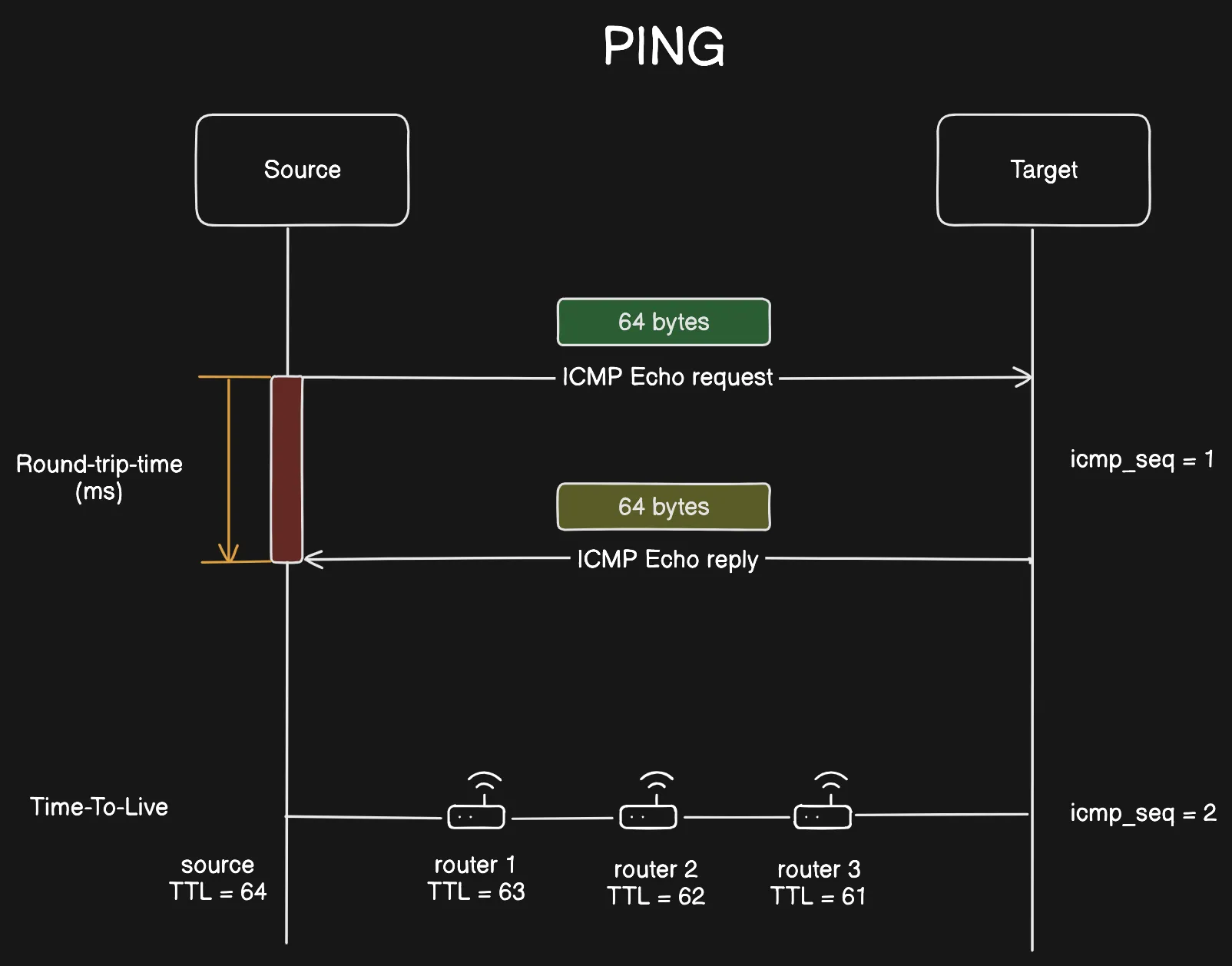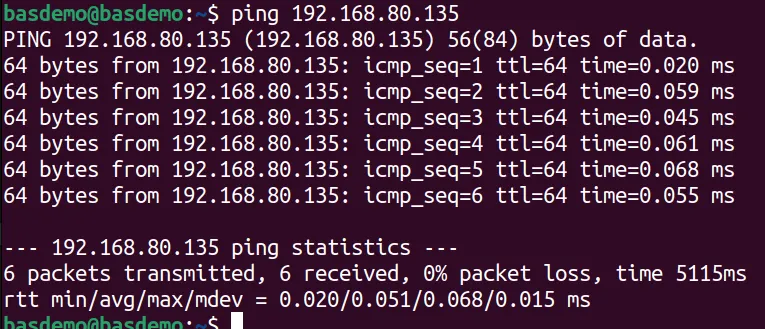Ping - Deep dive - Understanding the whats, whys and how it works?
Introduction
Ping is a utility tool used for monitoring the accessibility of host available in a network. It is virtually installed in every operating system that has networking capability.
A brief history
-
The ping utility was written by Mike Muuss in December 1983 during his time at the Ballistic Research Laboratory, now the US Army Research Laboratory.
-
A remark by David Mills on using ICMP echo packets for IP network diagnosis and measurements prompted Muuss to create the utility to troubleshoot network problems.
-
He named it after the sound that sonar makes, since its methodology is analogous to sonar’s echolocation.
-
The backronym
Packet InterNet Groperfor PING has been used for over 30 years, and although Muuss says that from his point of view PING was not intended as an acronym, he has acknowledged Mills’ expansion of the name. -
Further reading:
How it works?
- Ping operates by means of Internet Control Message Protocol (ICMP) packets.
- Pinging involves sending an
ICMP echo requestto the target host and waiting for anICMP echo reply. - The program reports errors, packet loss, and a statistical summary of the results, typically including the minimum, maximum, the mean round-trip times, and standard deviation of the mean.

- The command-line options of the ping utility and its output vary between the numerous implementations.
- Options may include the size of the payload, count of tests, limits for the number of network hops (TTL) that probes traverse, interval between the requests and time to wait for a response.
Below is the sample execution in ubuntu OS.

Terminologies
-
ICMP- The Internet Control Message Protocol (ICMP) is a supporting protocol in the Internet protocol suite. It is used by network devices, including routers, to send error messages and operational information indicating success or failure when communicating with another IP address. -
Checksum- The Internet checksum is used to detect errors in ICMP packets (including data payload).The checksum field is the 16 bit one’s complement of the one’s complement sum of all 16 bit words in the header. For purposes of computing the checksum, the value of the checksum field is zero.
-
Echo Request- This is an ICMP packet sent by the source machine. In the example, 64 bytes ICMP packet
-
Echo Reply- Once the packet reaches the destination machine, it sends back an echo reply ICMP packet.
-
Round Trip Time- The total time measuring from sending the echo request from the source machine until the echo reply packet is recieved by the source machine. -
Time To Live- It is either a counter or a timestamp, which every device (such as an intermediate router) forwarding an IP datagram first decrements the time to live (TTL) field in the IP header by one. If the resulting TTL is 0, the packet is discarded and an ICMP time exceeded message is sent to the datagram’s source address.
-
Sequence number- It denotes the number of round-trips initiated by the source machine.
Sample ping implementation
The script requires administrator or root previliges, since it requires access to sockets.
import osimport structimport socketimport time
def calculate_checksum(packet): """Calculate ICMP checksum""" checksum = 0 countTo = (len(packet) // 2) * 2
for count in range(0, countTo, 2): thisVal = packet[count + 1] * 256 + packet[count] checksum += thisVal checksum &= 0xffffffff
if countTo < len(packet): checksum += packet[-1] checksum &= 0xffffffff
checksum = (checksum >> 16) + (checksum & 0xffff) checksum += checksum >> 16 checksum = ~checksum checksum &= 0xffff checksum = checksum >> 8 | (checksum << 8 & 0xff00) return checksum
def send_ping(sock, dest_addr, icmp_id, seq_number): """Send ICMP Echo Request""" # Header is type (8), code (8), checksum (16), id (16), sequence (16) icmp_type = 8 # ICMP Echo Request icmp_code = 0 icmp_checksum = 0 icmp_packet_id = icmp_id icmp_sequence = seq_number icmp_payload = b'PingPingPingPingPing'
# Build ICMP header icmp_header = struct.pack("!BBHHH", icmp_type, icmp_code, icmp_checksum, icmp_packet_id, icmp_sequence) icmp_checksum = calculate_checksum(icmp_header + icmp_payload)
# Build ICMP packet icmp_packet = struct.pack("!BBHHH", icmp_type, icmp_code, icmp_checksum, icmp_packet_id, icmp_sequence) + icmp_payload
# Send the packet sock.sendto(icmp_packet, (dest_addr, 1))
def receive_ping(sock, icmp_id, seq_number, start_time): """Receive ICMP Echo Reply""" timeout = 3 # Set timeout to 3 seconds while True: sock.settimeout(timeout) try: packet, addr = sock.recvfrom(1024) icmp_header = packet[20:28] icmp_type, icmp_code, icmp_checksum, \ icmp_packet_id, icmp_sequence = struct.unpack( "!BBHHH", icmp_header) if icmp_packet_id == icmp_id and icmp_sequence == seq_number: end_time = time.time() return end_time - start_time except socket.timeout: return None
def ping(host, count=4): """Ping the specified host""" try: dest_addr = socket.gethostbyname(host) except socket.gaierror: print("Invalid hostname.") return
print(f"Pinging {host} [{dest_addr}] with {count} packets:")
icmp_id = os.getpid() & 0xFFFF
for seq_number in range(1, count + 1): sock = socket.socket(socket.AF_INET, socket.SOCK_RAW, socket.getprotobyname("icmp")) start_time = time.time() send_ping(sock, dest_addr, icmp_id, seq_number) round_trip_time = receive_ping(sock, icmp_id, seq_number, start_time) if round_trip_time is not None: print(f"Reply from {dest_addr}: icmp_seq={seq_number} time={round(round_trip_time * 1000, 2)}ms") else: print("Request timed out.") sock.close()
if __name__ == "__main__": ping("192.168.80.135")Output
sudo python ping.py# Pinging 192.168.80.135 [192.168.80.135] with 4 packets:# Reply from 192.168.80.135: icmp_seq=1 time=0.73ms# Reply from 192.168.80.135: icmp_seq=2 time=0.05ms# Reply from 192.168.80.135: icmp_seq=3 time=0.06ms# Reply from 192.168.80.135: icmp_seq=4 time=0.03ms
